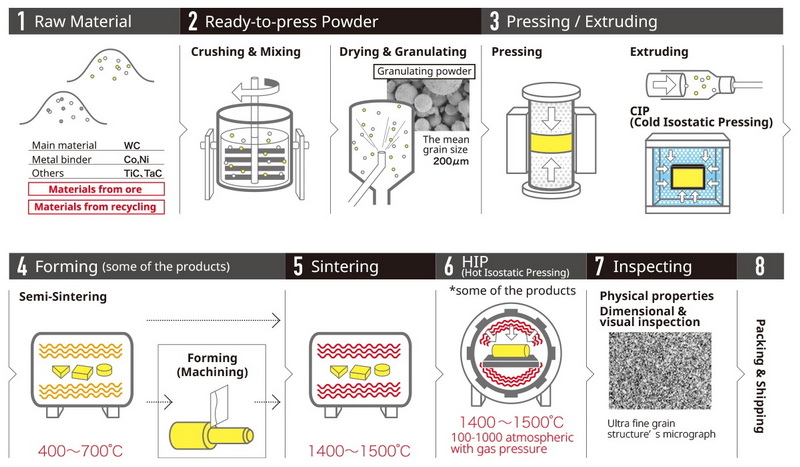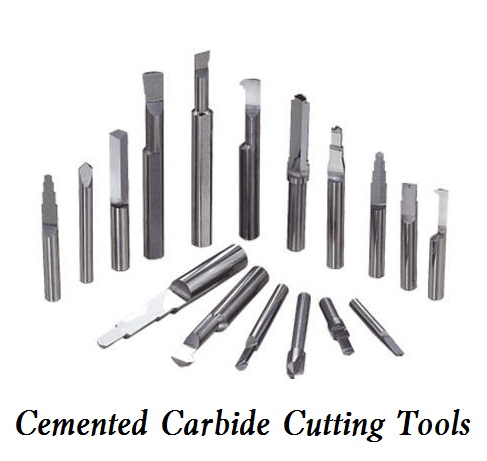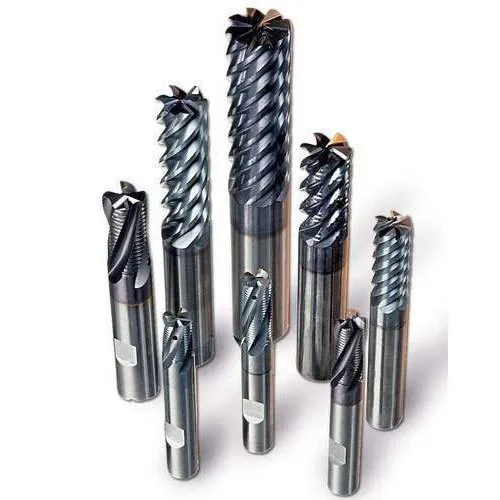Content Menu
● Introduction
● What is Tungsten Carbide?
● The Manufacturing Process: A Step-by-Step Guide
>> 1. Powder Preparation
>> 2. Mixing with Binder
>> 3. Milling
>> 4. Adding Binder (Wax)
>> 5. Pressing
>> 6. Presintering
>> 7. Machining (Pre-Sintered State)
>> 8. Sintering
>> 9. Grinding and Finishing
>> 10. Coating (Optional)
● Applications of Tungsten Carbide Cutting Tips
● Advantages of Tungsten Carbide Cutting Tips
● Challenges in Machining Tungsten Carbide
● Quality Control and Testing
● Advanced Techniques and Future Trends
● Conclusion
● FAQ
>> 1. What is the primary advantage of using tungsten carbide cutting tips?
>> 2. What materials can be machined using tungsten carbide cutting tips?
>> 3. How does the addition of cobalt enhance the properties of tungsten carbide?
>> 4. What are some common coatings used on tungsten carbide cutting tips, and what benefits do they offer?
>> 5. What are the challenges in machining tungsten carbide itself?
● Citations:
Introduction
Tungsten carbide cutting tips are essential components in various machining operations, prized for their hardness, wear resistance, and ability to maintain a sharp cutting edge at high temperatures[9][10]. These properties make them ideal for cutting materials such as steel, aluminum, composites, and even other carbides[2][5][10]. This article explores the manufacturing process of tungsten carbide cutting tips, from the initial powder preparation to the final sintering and coating stages. We will also discuss the applications, advantages, and frequently asked questions about these tools.

What is Tungsten Carbide?
Tungsten carbide is a composite material made from tungsten and carbon atoms, typically with a metallic binder like cobalt[1][7]. The resulting material is exceptionally hard, with hardness levels between diamond and sapphire, and approximately twice the weight of iron[4]. Its high hardness and heat resistance make it suitable for high-speed machining applications[2].
The Manufacturing Process: A Step-by-Step Guide
The manufacturing of tungsten carbide cutting tips involves several key steps, each critical to achieving the desired properties and performance[1].
1. Powder Preparation
The first step involves mixing tungsten metal, carbon black, and metal oxides[1]. This mixture is then heated until the carbon bonds with the tungsten in a process called carburization[1].
Mix Carbon black, Tungsten metal and metal oxides[1].
Then heat the mixture until the carbon bonds with the tungsten (carburises)[1].
The result is tungsten carbide powder[1].
2. Mixing with Binder
The tungsten carbide powder is mixed with a binder material, commonly cobalt[1][7]. Cobalt acts as a "glue" to hold the carbide grains together[7]. The mixture typically contains between 6% and 16% cobalt by weight[1].
Mix the tungsten carbide powder with wax and cobalt[1].
3. Milling
The mixture is then milled to ensure a uniform distribution of the tungsten carbide grains and cobalt[1]. Ball milling, using tungsten carbide balls, is a common method to achieve even dispersal[1].
Take this and mix very thoroughly using a ball mill[1].
This gives you a final powder[1].
4. Adding Binder (Wax)
Wax is added to the powder mixture as a binder[1]. The wax helps to hold the powder together and provides lubrication during the pressing process[1].
This powder is then dried and wax is added as a binder[1]. The wax holds the powder together and makes it somewhat slippery so it presses into shapes well[1].
5. Pressing
The powder is placed into a mold and pressed into the desired shape[1][4]. This can be achieved through various methods, including uniaxial pressing, isostatic pressing, or extrusion[4].
Put the final powder in a mold and press it to the desired shape[1].
6. Presintering
The pressed compacts are then presintered in a controlled atmosphere furnace at temperatures between 1,000°F and 1,500°F[1]. This process removes the wax and causes the material to stick together, resulting in a chalk-like consistency[1].
Heat (presinter) the pressed, final powder enough so that is sticks together like soft chalk[1].
7. Machining (Pre-Sintered State)
The presintered material, while still soft, can be easily machined into the final desired shape[1]. This allows for precise shaping before the final hardening[1].
Take the soft chalk and do your final machining / shaping[1].
8. Sintering
The machined parts undergo final sintering in a high-temperature, high-pressure furnace with a special atmosphere[1][4]. Sintering is typically performed at temperatures around 1400°C[4]. This process causes the material to shrink and densify, achieving its final hardness and strength[1].
Put the soft chalk pieces in a very hot, high pressure, special atmosphere oven and do the final sinter[1].
The powder cooks, shrinks and gets very hard[1].
9. Grinding and Finishing
After sintering, the tungsten carbide cutting tips are ground to achieve the final dimensions and surface finish[7][9]. Diamond grinding wheels are commonly used due to the material's extreme hardness[9].
10. Coating (Optional)
To further enhance the performance and lifespan of the cutting tips, coatings may be applied[7]. Common coatings include titanium nitride (TiN), titanium carbonitride (TiCN), and aluminum oxide (Al2O3)[7]. These coatings improve wear resistance, reduce friction, and increase cutting speed[7].
Strong negative charge is applied to the inserts[7]. A piece of titanium, or titanium and aluminum is installed on the wall or floor of the furnace[7]. The metal is vaporized by either an electric arc or an electron beam, liberating the positively charged metal ions[7]. These ions are attracted to the negatively charged inserts[7]. Nitrogen and methane are added as appropriate, to achieve the different types of coatings[7].
Applications of Tungsten Carbide Cutting Tips
Tungsten carbide cutting tips are used in a wide range of applications due to their exceptional properties[8][10].
- Milling: Carbide end mills are commonly used for material removal, providing a smooth and accurate finish on materials like aluminum, steel, and titanium[5].
- Drilling: Carbide drills are ideal for creating holes in materials such as steel, aluminum, and cast iron, withstanding high temperatures and speeds[5].
- Turning: Carbide inserts are used in turning operations, which involve rotating the workpiece while the cutting tool removes material[5].
- Reaming: Carbide reamers are used to enlarge and finish existing holes, producing a smooth and accurate finish[5].
- Sawing: Tungsten carbide is used in saw blades for cutting various materials, offering high hardness and wear resistance[10].

Advantages of Tungsten Carbide Cutting Tips
- High Hardness: Allows for cutting of hard materials[5].
- Wear Resistance: Extends tool life, reducing the need for frequent replacements[5].
- Heat Resistance: Maintains cutting performance at high temperatures[2].
- Versatility: Suitable for machining a wide range of materials, including wood, metals, plastics, and composites[2].
- Precision: Provides smooth and accurate finishes[5].
Challenges in Machining Tungsten Carbide
Due to its extreme hardness, machining tungsten carbide poses significant challenges[9]. Traditional machining processes like turning, milling, and drilling are not effective[9]. Special techniques such as diamond grinding, electrical discharge machining (EDM), and the use of PCD (polycrystalline diamond) or CBN (cubic boron nitride) tools are required[9].
Quality Control and Testing
Throughout the manufacturing process, rigorous quality control measures are implemented to ensure the cutting tips meet the required specifications. These measures include:
- Powder Analysis: Verifying the composition, particle size, and purity of the tungsten carbide and cobalt powders.
- Density Measurement: Ensuring the pressed and sintered parts achieve the desired density.
- Hardness Testing: Measuring the hardness of the cutting tips using methods like Rockwell or Vickers hardness tests.
- Microstructural Analysis: Examining the microstructure of the material to ensure uniform grain size and distribution.
- Dimensional Inspection: Verifying the dimensions and tolerances of the cutting tips.
- Cutting Performance Testing: Evaluating the cutting performance of the tips under various machining conditions.
Advanced Techniques and Future Trends
The manufacturing of tungsten carbide cutting tips is continuously evolving with the development of new techniques and technologies. Some notable advancements include:
- Nano-structured Carbides: Using nano-sized tungsten carbide powders to improve the hardness, toughness, and wear resistance of the cutting tips.
- Additive Manufacturing: Employing 3D printing techniques to create complex cutting tip geometries with improved performance characteristics.
- Advanced Coating Technologies: Developing new coating materials and methods to enhance the wear resistance, thermal stability, and cutting speed capabilities of the tips.
Conclusion
Tungsten carbide cutting tips are indispensable tools in modern machining, offering a unique combination of hardness, wear resistance, and heat resistance[9][10]. The manufacturing process involves a series of carefully controlled steps, from powder preparation and mixing to pressing, sintering, and coating[1]. Continuous advancements in materials, techniques, and technologies are further enhancing the performance and expanding the applications of these essential cutting tools.

FAQ
1. What is the primary advantage of using tungsten carbide cutting tips?
Tungsten carbide cutting tips offer a superior combination of hardness, wear resistance, and heat resistance, allowing them to maintain a sharp cutting edge and deliver consistent performance in demanding machining applications[9][10].
2. What materials can be machined using tungsten carbide cutting tips?
Tungsten carbide cutting tips can efficiently machine a wide variety of materials, including hardwood, softwood, plywood, MDF, chipboard, aluminum, non-ferrous metals, plastic composites, fiberglass, and foam[2].
3. How does the addition of cobalt enhance the properties of tungsten carbide?
Cobalt acts as a binder, holding the tungsten carbide grains together[1][7]. It improves the toughness and strength of the material while maintaining its hardness and wear resistance[7].
4. What are some common coatings used on tungsten carbide cutting tips, and what benefits do they offer?
Common coatings include titanium nitride (TiN), titanium carbonitride (TiCN), and aluminum oxide (Al2O3)[7]. These coatings enhance wear resistance, reduce friction, and increase cutting speed[7].
5. What are the challenges in machining tungsten carbide itself?
Due to its extreme hardness, tungsten carbide cannot be machined using traditional methods[9]. Special techniques such as diamond grinding and electrical discharge machining (EDM) are required[9].
Citations:
[1] https://carbideprocessors.com/pages/carbide-parts/tungsten-carbide-tips.html
[2] https://primatooling.co.uk/understanding-the-basics-of-tct-cutting-tools-a-guide-to-their-importance/
[3] https://www.ee.cityu.edu.hk/~gchen/pdf/Writing.pdf
[4] https://www.mmc-carbide.com/in/technical_information/tec_guide/tec_guide_carbide
[5] https://epictool.ca/carbide-cutting-tools-the-most-common-uses-for-carbide/
[6] https://blog.csdn.net/qq_34917728/article/details/125122327
[7] https://todaysmachiningworld.com/magazine/how-it-works-making-tungsten-carbide-cutting-tools/
[8] https://www.7leaders.com/blog/tungsten-carbide
[9] https://www.hit-tw.com/newsdetails.aspx?nid=298
[10] https://www.sollex.se/en/blog/post/about-cemented-tungsten-carbide-applications-part-1
















